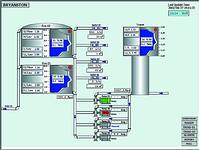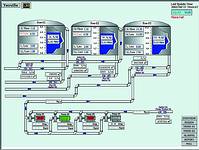

Johannesburg Water installed technologically advanced 32-bit, open automation Adroit scada systems to meet its standard throughput demands. As suppliers of clean water and sanitation services to Johannesburg’s expanding commercial and residential customer-base – on behalf of the City of Johannesburg – Johannesburg Water elected to install the Adroit scada at its six Waste Water Treatment Works and extensive reservoir network of 90 sites to optimise the city council’s assets through cutting edge technology.
As the 1990s drew to a close, the bulk of the organisations operations were running on a 20 year old Fulmen System (one of the first systems of its kind in South Africa) and its telemetry was on an HP A400 backbone. Johannesburg Water faced growing concerns about the system's robustness, efficiency and sustainability as it looked towards the challenges of becoming self-sustained in the new millennium.
Johannesburg Water sought a reputable local scada manufacturer offering a scalable and fit-for-purpose product, coupled with the cost advantages and readily available support associated with a local developer. Adroit Technologies matched the requirements. Edward Livesey, electrical support manager for Johannesburg Water adds, "Adroit is easy to configure, has substantial mimics and user friendly templates."

Business benefits of the Adroit scada HMI
Johannesburg Water contracted two systems integrators (SIs): SSE (Specialist System Engineering) and the WSP Group. "We believe that blending SIs speeds up work progress and facilitates troubleshooting on a large project," says Livesey, "Both SIs work extensively with Adroit, and this saved us money."
The Adroit scada HMI provides full plant monitoring and control across the full spectrum of Johannesburg Water's potable water and wastewater treatment works by means of a combination of radio, fibre-optics, cellular and PLC technology on site. At the pumping stations, the Adroit HMI monitors currents, temperatures, loads and pumping pressures to ensure early warning for the networks to time up GIS for the zoning metres to ring fence.
The scada monitors the water storage capacity of Johannesburg Water's extensive network of reservoirs and the Adroit advanced warning system allows the water works to optimise reservoir measurements. The business benefits to Johannesburg Water and its client base include the ability to avoid overflow, a condition that results in loss of revenue as well as undermining JW's ongoing Unaccounted for Water (UFW) initiatives. A further benefit is that unsafe situations due to overflows are minimised. Needless to say, interruptions to supply (due to reservoirs running dry) are just as important in this strategy.
In addition to the direct savings and safety benefits, the predictive maintenance system enabled by the Adroit scada allows for improved accuracy in ordering on reservoir volumes and capacities - Johannesburg Water is then able to pass these savings on to consumers. The automated data acquisition and control capabilities eliminate costly overtime associated with physically manning the stations.
Northern Works, Johannesburg Water's most power intensive plant, also uses the Adroit scada to monitor maximum demand on electricity allowing the organisation to optimise its assets amounting to further savings for customers. The organisation plans to link its system to an energy management programme in the future.
Telemetry and the centralisation of supervisory data and control remote alarms at the clear water sites are linked through a master control station situated at the head office in downtown Johannesburg that operates 24/7. By centralising this function, the organisation has been able to streamline the utilisation of fitters, plumbers and other maintenance crews thereby reducing the need for unnecessary maintenance call-outs and providing further financial benefits.
The transmission of data from Johannesburg Water's 120 outstations to the head office is made possible by digipeater technology, believed to be a world first, created by local manufacturers SSE. Neville Enslin of SSE explains that by using the store and forward capability of the SSE-RTU, SSE is able to create a digital repeater, or digipeater for the transmission of data to remote stations. The digipeater can relay signals on a single frequency thereby negating the need for cumbersome repeaters. Standard SSE protocol is to install multiple digipeater paths and thus have ensured total redundancy for Johannesburg Water.
"The SSE telemetry system also facilitates different communications mediums and supports mixed communication networks," says Enslin. Johannesburg Water utilises a site situation dictated combination of cellular technology, currently being installed at its sanitation sites, and radio signals at all reservoirs and pumps stations where the Adroit scada and the RTU communicate at a 9600-board rate using data radio which is connected directly to the PLC.
Mission critical data such as I/O mapping, pump runs, trips, levels and flows is received by the RTU and transmitted via FSK two-way radio signals on a UHF frequency to the central station. The information is then fed to a second RTU for translation before being received by the OPC and simultaneously fed to the Adroit scada and the SQL Server as a time saving mechanism eliminating the delay in having information travel to the server only after it has been through the scada. Additional benefits to this configuration include the prevention of file manipulation that takes place in the scada and having the Adroit system function as a hot back up to the SQL database located on a Raid 5 backbone.
In addition to enabling communication from master to remote, the systems telemetry network enables peer-to-peer communication between RTUs and facilitates remote configuration from the OPC. Johannesburg Water's extensive network encompasses in excess of 80 radio stations and 42 cellphone stations.
The SSE system is palm-sized, with portable radios installed at the potable water outstation site, and mobile units used at the digipeaters and base station. The system is both compact and powerful, spanning an impressive 120 km from Johannesburg Water's most northern RTU at Randjeslaagte in Centurion to Portjie near Vereeniging in the South.
Each RTU is fully programmable and has a standard eight digital input, eight digital outputs and eight analog inputs. All RTU enhancements can be downloaded via radio or cellular communication from the OPC remotely facilitating function changes such as I/O configuration, RTU control programming, and digipeater paths via the master computer (OPC). The cellular system includes canned messaging for up to 255 phone numbers enabling expeditious warning using predetermined message alarms. Cellphone commands can be sent via the RTU to pumps and other mission critical equipment requesting status reports that are supplied and generated by the RTU which has the capacity for data logging. The wastewater treatment plants use cellular-based alarming to alert maintenance crews and plant operations personnel of plant failures or inadequacies. Installed by SSE, cellular transmitters attached to the OPC and RTU facilitate communication either through a dial-up or SMS system that is decoded in the OPC.
Via the telemetry system, Johannesburg Water's Head Office receives all trending and historical data used by the technical and operations staff. This in turn forms the basis of the predictive and preventative maintenance system. An interface with Opus Business Report Writing and Analysis software ensures that operational security is maintained while providing management with an easy to use tool to map trends.
The scada system is running on Windows 2000, with the server forming an operations platform for the Windows 2000 enabled workstations. Johannesburg Water created custom graphics to mix with the standard Adroit mimics creating the desired visual effect and representation of the treatment works. The organisation also benefited from sharing mimics with other Adroit user groups, which Adroit is currently consolidating under a user-based forum website for graphic swapping and other user exchanges. The standard Adroit scada package adequately met Johannesburg Waters needs and did not require out of the ordinary configuration or scripting.
Olifantsvlei Johan Grobler, control and instrumentation manager and principal associate for the WSP Group installed Adroit at Johannesburg Water's largest site, Olifantsvlei. The site has a daily waste water treatment capacity of 190 megalitres and handles all the secondary sludge produced by its sister plant, Bushkoppies, as well as effluent from a large area south of Johannesburg (Soweto).
The operation of Olifantsvlei is decoupled into two sections: Unit 3, a wastewater treatment facility fully installed on the Adroit scada, and the Regional Sludge Handling Facility that is still run partially on manual. The plant has over 5000 operational tag points on an unlimited tag system for expansion and operates on Windows NT and Adroit Version 4.1.
At Unit 3, the Adroit installation consists of a master Adroit and one remote node connecting 10 Modicon 984 series PLCs (majority 984-385Es and some 685Es) communicating on a Modbus Plus Network. The scada monitors and controls the three key components in the waste water treatment process:
1. The aerators that provide oxygen to the wastewater vital to the bio-organic process used in the breakdown of raw sludge.
2. The bioreactors, a combination of aerators and mixers which keeps the solids in suspension.
3. The pumps that transfer the matter to other areas of the facility. Adroit currently runs approximately 20% of the aerators, 40% (or 16) mixers, and 20% of the pumps.
The WSP Group used the standard Adroit package and generated its own symbols for the aerators in bitmap using the Adroit mimic, "It was simple and easy to use," said Grobler.
The scada also monitors the temperatures, flows, oxygen levels, suspended solid levels and graphically reflects these readings. In conjunction with the PLCs, the Adroit system also opens the valves and penstocks used in the process.
Reporting is carried out in Excel, on a spreadsheet custom developed by Adroit for this purpose. Historical data and trending is operational with motors, flows, and all analog signals being logged and trended. A UPS provides stable power to the system, and data is backed-up onto CD.
WSP used Expressions scripting to set and reset plant operational equipment and calculate values by first breaking them into integers and then adding them with expression.
The Regional Sludge Handling Plant, where the standalone scada monitors 10 PLCs and provides remote graphic representation of the facility and user interface to 10 000 tag points also monitors the facilities 10 dewatering bell pressers used to extract water and controls various other capital assets employed in the manufacture of compost from sludge.
The WSP group also installed Adroit at the Ennerdale, Northern Works, Goudkoppies and Bushkoppies facilities.
For more information contact Dave Wibberley, MD, Adroit Technologies, 011 781 3513, [email protected], www.adroit.co.za
| Tel: | +27 11 658 8100 |
| Email: | [email protected] |
| www: | www.adroit.co.za |
| Articles: | More information and articles about Adroit Technologies |
© Technews Publishing (Pty) Ltd | All Rights Reserved